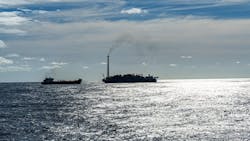TotalEnergies announces FID for GranMorgu development offshore Suriname
TotalEnergies reports that it has issued the final investment decision on the $10.5-billion GranMorgu development project offshore Suriname.
The project calls for construction of a new FPSO unit to develop and process production from the Sapakara and Krabdagu oil discoveries in Block 58.
Patrick Pouyanné, Chairman and CEO of TotalEnergies, met in Paramaribo, the capital of Suriname, along with Chandrikapersad Santokhi, President of the Republic of Suriname, and Annand Jagesar, CEO of Staatsolie Maatschappij Suriname N.V., Suriname’s national oil company, to announce the decision.
“GranMorgu” means both “new dawn” and “Goliath grouper” in Sranan Tongo, the local language.
The GranMorgu project will develop the Sapakara and Krabdagu oil discoveries, on which a successful exploration and appraisal campaign was completed in 2023. The fields are located 150 km off the coast of Suriname and hold recoverable reserves estimated at over 750 MMbbl.
The project will include an FPSO capable of storing and processing 220,000 b/d of oil. The GranMorgu FPSO will be designed to accommodate future tieback opportunities that would extend its production plateau. First oil is expected in 2028.
TotalEnergies is the operator of Block 58 with a 50% interest, alongside APA Corporation (50%). Staatsolie has announced its intent to exercise its option to enter the development project with up to 20% interest. Partners agreed that Staatsolie will contribute to the project from FID and will finalize its interest before June 2025.
The GranMorgu project will features several technologies designed to minimize greenhouse gas emissions, with a scope 1 and 2 emissions intensity below 16 kg CO2e/boe that derives from the following technologies:
- An all-electric FPSO configuration, with zero routine flaring and full reinjection of associated gas into the reservoirs
- An optimized power usage with a waste heat recovery unit and optimized water cooling for improved efficiency
- The installation of a permanent methane detection and monitoring system relying on a network of sensors.
